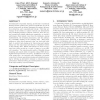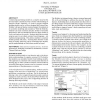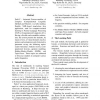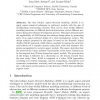39 search results - page 6 / 8 » Modular learning models in forecasting natural phenomena |
ECCV
2006
Springer
14 years 10 months ago
2006
Springer
Abstract. Bottom-up approaches, which rely mainly on continuity principles, are often insufficient to form accurate segments in natural images. In order to improve performance, rec...
KDD
2005
ACM
14 years 9 months ago
2005
ACM
Discriminative sequential learning models like Conditional Random Fields (CRFs) have achieved significant success in several areas such as natural language processing, information...
CHI
1995
ACM
14 years 4 days ago
1995
ACM
The Modeler is designed using a learner-centered approach [5], with scaffolding to address the specific needs of learners. Scaffolding [3] is an educational term that refers to pro...
ACL
2009
13 years 6 months ago
2009
ProLiV - Animated Process-modeler of Complex (Computational) Linguistic Methods and Theories - is a fully modular, flexible, XML-based stand-alone Java application, used for compu...
TAOSD
2010
13 years 3 months ago
2010
The idea behind Aspect-Oriented Modeling (AOM) is to apply aspect-oriented techniques to (software) models with the aim of modularizing crosscutting concerns. This can be done with...




